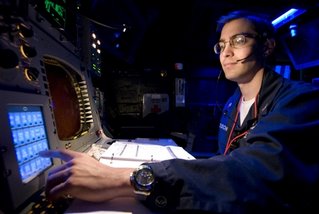


|

|
|
|
Home |
The Mil & Aero Blog
 Posted by John Keller The shootdown this week of a malfunctioning U.S. radar surveillance satellite, known as USA-193, has got to be one of the biggest Chicken-Little stories I've seen in a long time. The picture I got from the mainstream press was of an out-of-control spacecraft filled with deadly poison careening toward world population centers to create a disaster of epic proportions in just days or even hours. It was right out of a Marvel comic book. So the U.S. Navy stepped in and proposed to shoot the rogue satellite down with a ship-based SM-3 missile, originally designed to shatter the warheads of incoming intercontinental ballistic missiles. That ought to take care of the problem. But you CAN'T, the press wailed. If you shoot it down you'll create an orbiting cloud of poison and lethal metal shrapnel that's the size of Texas ... or Alaska ... or, well, that will be really big! What would happen if that came down on downtown Toledo? Well, maybe we shouldn't shoot it down, the Pentagon suggested. But you HAVE to shoot it down, the press cried. What if that satellite's fuel tank of poison hydrazine actually hit the Earth intact? Imagine the fatalities! All right, already, the Navy sighed. We'll shoot it down. Just relax! Well, just do it so ... nothing bad happens, the press nagged, offering to repeat in gory detail the long lists of potential disasters from shooting it down -- or not shooting it down -- that had been churned out for days and days. So the Navy shot it down Wednesday night. We're saved ... unless anyone gets hit by a piece of satellite or gets a whiff of hydrazine. If that happens there'll be Hell to pay. Let's keep our fingers crossed. All during these bouts of public weeping and gnashing of teeth, I wondered what the big deal was. Let's look at the options. First, what if we did nothing? Well, the satellite would probably burn up on re-entering the Earth's atmosphere, with a few residual small pieces falling in the ocean or in some farmer's field. The hydrazine fuel would ignite in the atmosphere, with little likelihood that any would make it to the ground. Space junk does fall out of the sky from time to time, you know. On a visit to the Air Force Space Command in Los Angeles a few years ago, I noticed several blackened chunks of metal mounted on pedestals on display. I asked what they were, and they turned out to be space junk that fell out of orbit and landed on the ground as they were. Some were pretty big, too. I never heard about even one of those rogue space chunks when they fell out of the sky. Funny how that could happen. Okay, what about the second option of shooting the satellite down? A satellite is slower and more predictable than an incoming ICBM warhead, so this most likely would be a pretty easy shot for the Navy's SM-3 missiles tipped with the Lightweight Exo-Atmospheric Projectile (LEAP). Let's see now, that rogue satellite was traveling at about 17,000 miles per hour. The SM-3, once it gets moving, goes about 6,000 miles an hour. Even at an oblique angle, think of the closing speed. I've seen some pretty hairy car crashes out on Route 128 near Boston, where there wasn't much left. Those cars were probably going about 60 miles an hour, give or take. I really don't think there was much left of the satellite after that LEAP-tipped SM-3 got through with it. I had to laugh when people wondered if the missile would break the satellite's fuel tank. So what did we achieve by shooting down that satellite? Much, actually, and none of it had anything whatsoever to do with averting a disaster. Remember when the Chinese used a missile to shoot down one of their own satellites about a year ago? I think shooting down USA-193 was just a nice way to let the Chinese know that we can do it, too. We'd probably also be pretty good at shooting down incoming ICBMs. Everyone see that? So there it is. But I guess it was a pretty fun ride while it lasted. I think it's safe to say, however, that if the U.S. and China ever get in a shooting war, that a lot of satellites are going to come down real fast. That's the other lesson of USA-193. The photo above is of U.S. Navy Petty Officer 2nd Class Andrew Jackson as he activates a modified tactical SM-3 missile from the guided missile cruiser USS Lake Erie last Wednesday. The accompanying video is the shootdown of a malfunctioning satellite. << Home |
Welcome to the lighter side of Military & Aerospace Electronics. This is where our staff recount tales of the strange, the weird, and the otherwise offbeat. We could put news here, but we have the rest of our Website for that. Enjoy our scribblings, and feel free to add your own opinions. You might also get to know us in the process. Proceed at your own risk. 
John Keller is editor-in-chief of Military & Aerospace Electronics magazine, which provides extensive coverage and analysis of enabling electronic and optoelectronic technologies in military, space, and commercial aviation applications. A member of the Military & Aerospace Electronics staff since the magazine's founding in 1989, Mr. Keller took over as chief editor in 1995.  Courtney E. Howard is senior editor of Military & Aerospace Electronics magazine. She is responsible for writing news stories and feature articles for the print publication, as well as composing daily news for the magazine's Website and assembling the weekly electronic newsletter. Her features have appeared in such high-tech trade publications as Military & Aerospace Electronics, Computer Graphics World, Electronic Publishing, Small Times, and The Audio Amateur.
Courtney E. Howard is senior editor of Military & Aerospace Electronics magazine. She is responsible for writing news stories and feature articles for the print publication, as well as composing daily news for the magazine's Website and assembling the weekly electronic newsletter. Her features have appeared in such high-tech trade publications as Military & Aerospace Electronics, Computer Graphics World, Electronic Publishing, Small Times, and The Audio Amateur.
 John McHale is executive editor of Military & Aerospace Electronics magazine, where he has been covering the defense Industry for more than dozen years. During that time he also led PennWell's launches of magazines and shows on homeland security and a defense publication and website in Europe. Mr. McHale has served as chairman of the Military & Aerospace Electronics Forum and its Advisory Council since 2004. He lives in Boston with his golf clubs.
John McHale is executive editor of Military & Aerospace Electronics magazine, where he has been covering the defense Industry for more than dozen years. During that time he also led PennWell's launches of magazines and shows on homeland security and a defense publication and website in Europe. Mr. McHale has served as chairman of the Military & Aerospace Electronics Forum and its Advisory Council since 2004. He lives in Boston with his golf clubs.
Previous Posts
Archives
|
|||||
|
THE MAE WEBSITE AUTHORS ARE SOLELY RESPONSIBLE FOR THE CONTENT AND ACCURACY OF THEIR BLOGS, INCLUDING ANY OPINIONS THEY EXPRESS, AND PENNWELL IS NOT RESPONSIBLE FOR AND HEREBY DISCLAIMS ANY AND ALL LIABILITY FOR THE CONTENT, ITS ACCURACY, AND OPINIONS THAT MAY BE CONTAINED HEREIN. THE CONTENT ON THE MAE WEBSITE MAY BE DATED AND PENNWELL IS UNDER NO OBLIGATION TO PROVIDE UPDATES TO THE INFORMATION INCLUDED HEREIN.
|
||||||
|
|
Home | About Us | Contact Us | Corporate Website | Privacy Policy | Courage and Valor Foundation | Site Map
Also Visit: Laser Focus World | Vision Systems Design | Industrial Laser Solutions Copyright © 2007: PennWell Corporation, Tulsa, OK; All Rights Reserved. | Terms & Conditions | Webmaster |
Friday, February 22, 2008 1:03:00 PM EST
Friday, February 22, 2008 3:50:00 PM EST